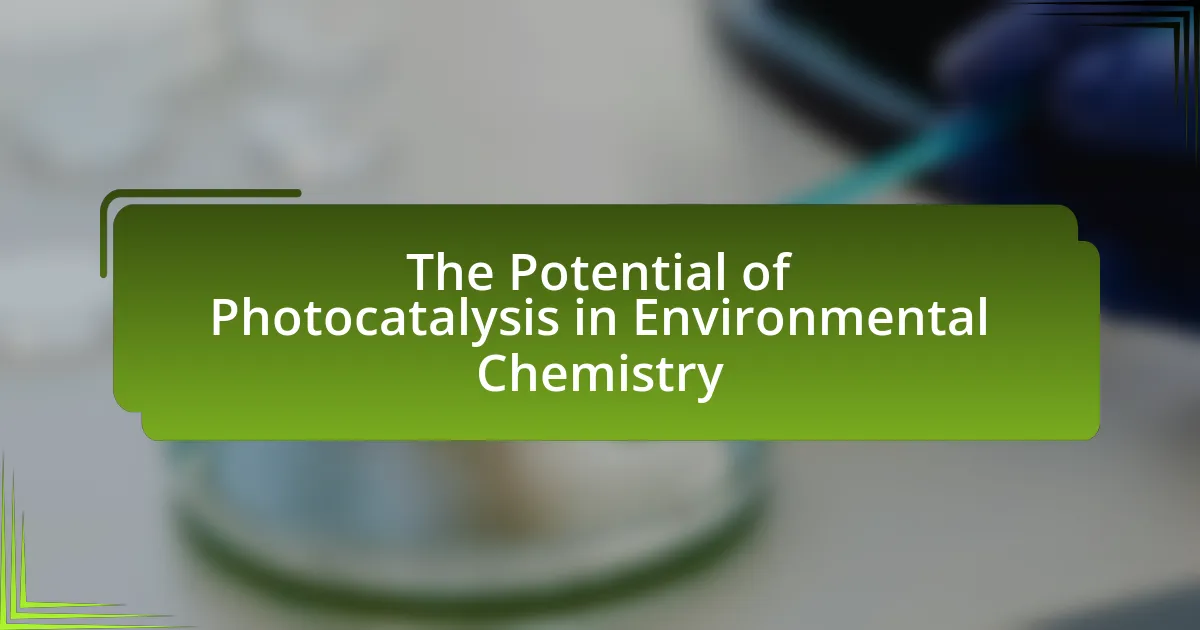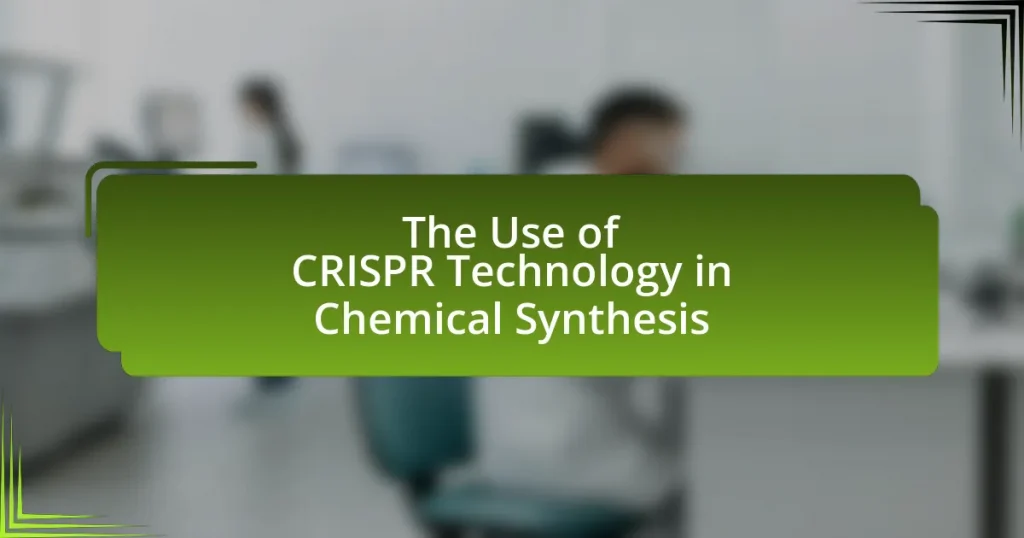Photocatalysis is a process in environmental chemistry that utilizes light to accelerate chemical reactions involving catalysts, primarily aimed at degrading pollutants and converting harmful substances into less toxic forms. This article explores the mechanisms of photocatalysis, particularly focusing on titanium dioxide as a key photocatalyst, and its applications in air and water purification. It highlights the effectiveness of photocatalytic processes in addressing environmental issues such as air pollution and water contamination, achieving significant degradation rates of various pollutants. Additionally, the article discusses the challenges and limitations of photocatalysis, including efficiency under natural light conditions and material stability, while also examining advancements in materials science that enhance photocatalytic efficiency.
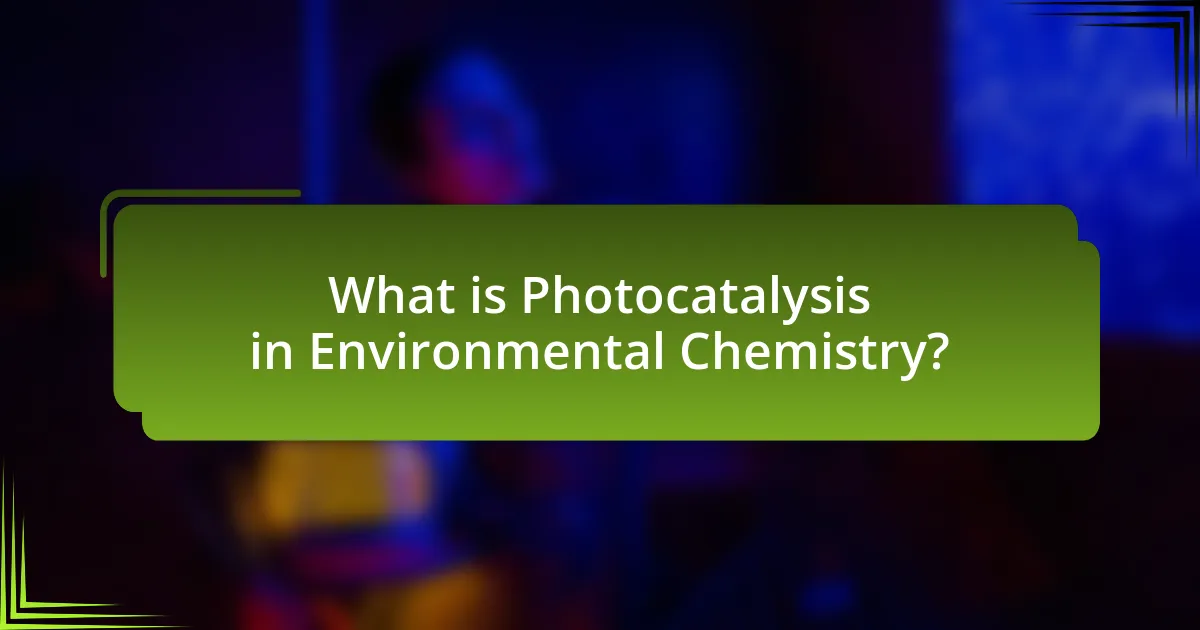
What is Photocatalysis in Environmental Chemistry?
Photocatalysis in environmental chemistry is a process that uses light to accelerate a chemical reaction involving a catalyst, typically to degrade pollutants or convert substances into less harmful forms. This mechanism is particularly effective in breaking down organic contaminants in water and air, as demonstrated by studies showing that titanium dioxide, a common photocatalyst, can effectively degrade various organic pollutants under UV light exposure. The ability of photocatalysis to harness solar energy for environmental remediation highlights its potential as a sustainable solution for pollution control.
How does photocatalysis function in environmental applications?
Photocatalysis functions in environmental applications by utilizing light energy to activate a catalyst, typically titanium dioxide, which facilitates chemical reactions that degrade pollutants. This process involves the absorption of photons, leading to the generation of electron-hole pairs that can react with water and oxygen to produce reactive species, such as hydroxyl radicals, which effectively break down organic contaminants in air and water. Studies have shown that photocatalytic processes can significantly reduce concentrations of harmful substances, such as volatile organic compounds and pathogens, demonstrating its effectiveness in purifying air and treating wastewater.
What are the key mechanisms involved in photocatalysis?
The key mechanisms involved in photocatalysis include the generation of electron-hole pairs, charge separation, and surface reactions. In photocatalysis, when a semiconductor material is exposed to light, photons excite electrons from the valence band to the conduction band, creating electron-hole pairs. This process is crucial as the generated electrons and holes can then migrate to the surface of the photocatalyst, where they participate in redox reactions. For instance, the electrons can reduce oxygen or other species, while the holes can oxidize water or organic pollutants. Studies have shown that the efficiency of photocatalysis is significantly influenced by factors such as the band gap of the semiconductor and the presence of co-catalysts, which can enhance charge separation and improve reaction rates.
How do different photocatalysts influence the process?
Different photocatalysts significantly influence the photocatalytic process by altering the efficiency of light absorption, charge separation, and reaction kinetics. For instance, titanium dioxide (TiO2) is widely used due to its strong photocatalytic activity under UV light, while other materials like zinc oxide (ZnO) and graphitic carbon nitride (g-C3N4) exhibit varying efficiencies under visible light. The bandgap energy of these photocatalysts determines their light absorption capabilities; TiO2 has a bandgap of about 3.2 eV, making it effective for UV light, whereas g-C3N4 has a lower bandgap of approximately 2.7 eV, allowing it to utilize visible light more effectively. Studies have shown that the choice of photocatalyst can lead to differences in reaction rates and product yields, with some materials promoting faster degradation of pollutants compared to others.
Why is photocatalysis important for environmental chemistry?
Photocatalysis is important for environmental chemistry because it enables the degradation of pollutants and the conversion of harmful substances into less toxic forms using light energy. This process utilizes photocatalysts, such as titanium dioxide, which can effectively break down organic contaminants in water and air, thereby improving environmental quality. Studies have shown that photocatalytic processes can achieve degradation rates of over 90% for various pollutants, making it a viable solution for addressing environmental contamination issues.
What environmental issues can photocatalysis address?
Photocatalysis can address several environmental issues, including air pollution, water contamination, and energy sustainability. Specifically, photocatalytic processes can degrade harmful pollutants such as volatile organic compounds (VOCs) and nitrogen oxides (NOx) in the atmosphere, thereby improving air quality. In water treatment, photocatalysis effectively breaks down organic contaminants and pathogens, making water safer for consumption. Furthermore, photocatalysis can facilitate the conversion of solar energy into chemical energy, contributing to renewable energy solutions. Studies have shown that titanium dioxide (TiO2) photocatalysts can achieve over 90% degradation of certain pollutants under UV light, demonstrating their efficacy in environmental remediation.
How does photocatalysis contribute to sustainable practices?
Photocatalysis contributes to sustainable practices by enabling the degradation of pollutants and the conversion of renewable resources into energy. This process utilizes light energy to activate a catalyst, typically titanium dioxide, which facilitates chemical reactions that break down harmful substances such as volatile organic compounds and pesticides into less harmful products. Studies have shown that photocatalytic processes can effectively reduce air and water pollution, with research indicating that titanium dioxide can degrade up to 90% of certain pollutants under UV light exposure. Additionally, photocatalysis can be employed in the production of hydrogen from water, offering a clean energy source that supports the transition to renewable energy systems.
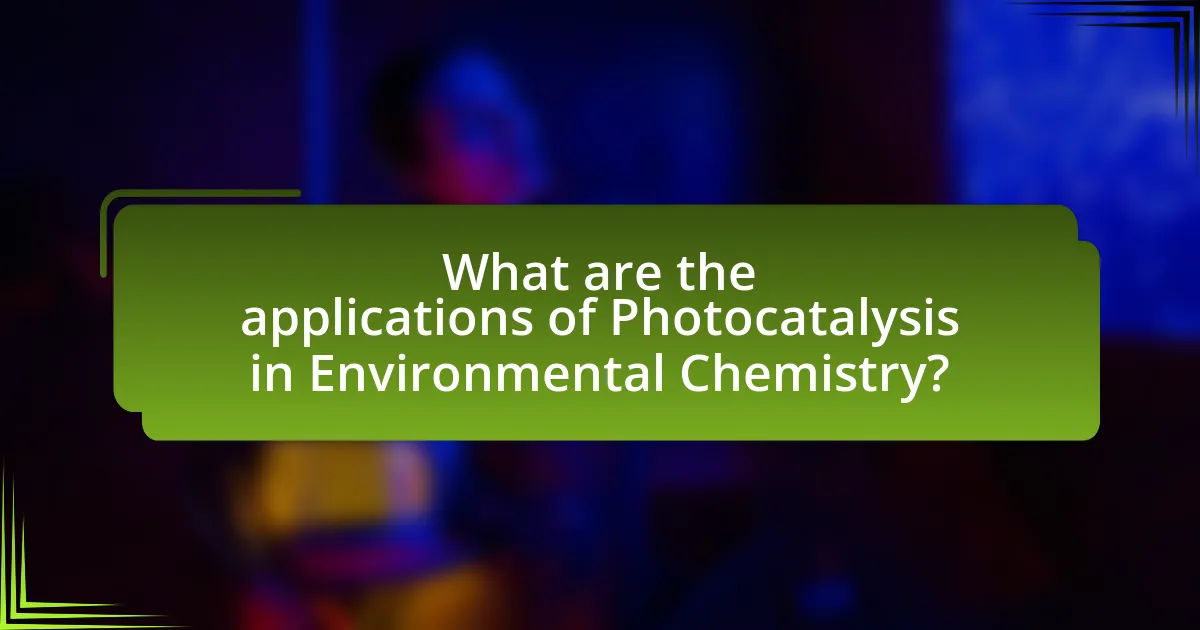
What are the applications of Photocatalysis in Environmental Chemistry?
Photocatalysis has several applications in environmental chemistry, primarily in the degradation of pollutants, water purification, and air treatment. This process utilizes light-activated catalysts, such as titanium dioxide, to accelerate chemical reactions that break down harmful substances. For instance, photocatalysis effectively decomposes organic contaminants in wastewater, achieving removal efficiencies exceeding 90% in some studies. Additionally, it is employed in air purification systems to eliminate volatile organic compounds and pathogens, contributing to improved indoor air quality. Research has demonstrated that photocatalytic processes can also facilitate the conversion of carbon dioxide into useful chemicals, thus addressing greenhouse gas emissions.
How is photocatalysis used in water treatment?
Photocatalysis is used in water treatment to degrade organic pollutants and pathogens through the activation of photocatalysts, typically titanium dioxide, under UV light. This process generates reactive oxygen species that break down contaminants into less harmful substances, effectively purifying the water. Studies have shown that photocatalytic processes can achieve over 90% removal efficiency for various organic compounds, including dyes and pharmaceuticals, demonstrating its effectiveness in treating wastewater.
What pollutants can be effectively removed using photocatalysis?
Photocatalysis can effectively remove pollutants such as volatile organic compounds (VOCs), nitrogen oxides (NOx), sulfur dioxide (SO2), and various organic dyes. Research indicates that titanium dioxide (TiO2) is a commonly used photocatalyst that facilitates the degradation of these pollutants under UV light exposure. For instance, studies have shown that TiO2 can degrade up to 90% of certain VOCs and organic dyes in a matter of hours, demonstrating its efficacy in air and water purification applications.
What are the advantages of photocatalytic water treatment over traditional methods?
Photocatalytic water treatment offers several advantages over traditional methods, including higher efficiency in degrading pollutants and the ability to operate under mild conditions. This method utilizes light to activate a catalyst, which accelerates the breakdown of contaminants, achieving removal rates that can exceed those of conventional chemical treatments. For instance, studies have shown that photocatalysis can effectively degrade organic pollutants like dyes and pharmaceuticals in a matter of hours, while traditional methods may take significantly longer. Additionally, photocatalytic processes can mineralize contaminants completely into harmless byproducts, reducing the need for secondary treatment steps often required in traditional systems.
In what ways does photocatalysis aid in air purification?
Photocatalysis aids in air purification primarily by facilitating the breakdown of harmful pollutants into less toxic substances. This process occurs when photocatalysts, such as titanium dioxide, are activated by light, generating reactive oxygen species that oxidize volatile organic compounds (VOCs) and other airborne contaminants. Studies have shown that photocatalytic materials can effectively degrade pollutants like formaldehyde and benzene, achieving removal efficiencies exceeding 90% under optimal conditions. Additionally, photocatalysis can reduce particulate matter and pathogens in the air, contributing to improved indoor air quality.
What types of air pollutants can be degraded by photocatalysis?
Photocatalysis can degrade various types of air pollutants, including volatile organic compounds (VOCs), nitrogen oxides (NOx), and particulate matter. Research indicates that photocatalytic processes effectively break down VOCs such as benzene, toluene, and formaldehyde, which are common indoor air pollutants. Additionally, photocatalysis has been shown to reduce nitrogen oxides, which contribute to smog formation, by converting them into less harmful substances. Studies have demonstrated that titanium dioxide (TiO2) as a photocatalyst can significantly enhance the degradation rates of these pollutants under UV light exposure, confirming its effectiveness in improving air quality.
How does photocatalysis improve indoor air quality?
Photocatalysis improves indoor air quality by utilizing light-activated catalysts, such as titanium dioxide, to break down harmful pollutants like volatile organic compounds (VOCs) and bacteria. This process occurs when light energy activates the photocatalyst, generating reactive oxygen species that oxidize and decompose these contaminants into less harmful substances, such as carbon dioxide and water. Studies have shown that photocatalytic materials can reduce indoor air pollutants by up to 90% under optimal conditions, demonstrating their effectiveness in enhancing air quality.
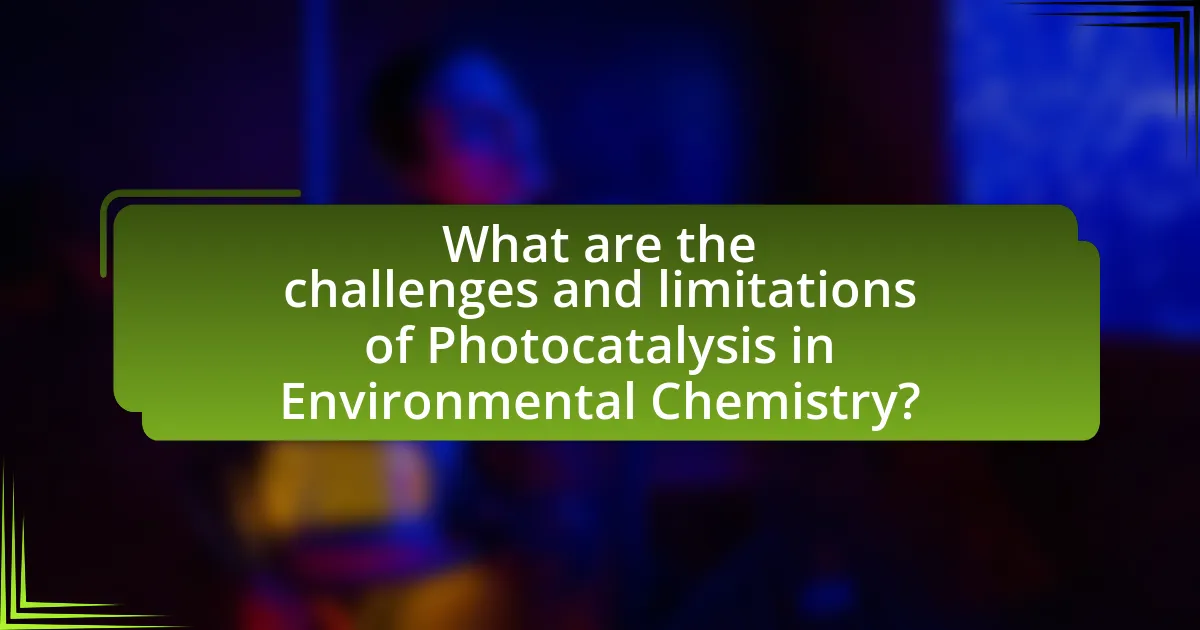
What are the challenges and limitations of Photocatalysis in Environmental Chemistry?
Photocatalysis in environmental chemistry faces several challenges and limitations, primarily including low quantum efficiency, limited light absorption, and the stability of photocatalysts. Low quantum efficiency refers to the ineffective conversion of absorbed light into chemical energy, which hampers the overall effectiveness of photocatalytic processes. Limited light absorption occurs because many photocatalysts, such as titanium dioxide, primarily absorb UV light, restricting their applicability under natural sunlight conditions. Additionally, the stability of photocatalysts can be compromised under prolonged exposure to environmental conditions, leading to degradation and reduced activity. These factors collectively hinder the practical implementation of photocatalysis for large-scale environmental remediation.
What are the main obstacles to the widespread adoption of photocatalysis?
The main obstacles to the widespread adoption of photocatalysis include high production costs, limited efficiency under natural light conditions, and challenges in material stability. High production costs arise from the synthesis of photocatalytic materials, which often require expensive precursors and complex fabrication processes. Limited efficiency under natural light conditions is a significant barrier, as many photocatalysts are optimized for specific wavelengths that do not align with the solar spectrum. Additionally, challenges in material stability, particularly under prolonged exposure to environmental conditions, can lead to degradation of photocatalytic performance, hindering long-term applications. These factors collectively impede the scalability and practical implementation of photocatalytic technologies in environmental chemistry.
How do economic factors impact the implementation of photocatalytic technologies?
Economic factors significantly influence the implementation of photocatalytic technologies by affecting research funding, production costs, and market demand. High initial investment costs can deter companies from adopting these technologies, as seen in the solar energy sector, where upfront expenses have historically limited widespread adoption. Additionally, government policies and incentives can either promote or hinder the development of photocatalytic solutions; for instance, subsidies for renewable energy technologies can enhance the economic viability of photocatalysis. Furthermore, the growing demand for sustainable solutions in industries such as water treatment and air purification creates a market that can drive innovation and reduce costs through economies of scale. Thus, economic considerations play a crucial role in determining the pace and extent of photocatalytic technology deployment.
What technical challenges must be overcome for effective photocatalysis?
Effective photocatalysis faces several technical challenges, including the need for efficient light absorption, charge carrier separation, and stability of photocatalytic materials. Efficient light absorption is crucial because many photocatalysts do not utilize the full solar spectrum, limiting their effectiveness. Charge carrier separation is essential to prevent recombination of electron-hole pairs, which diminishes photocatalytic activity; materials with suitable band gaps and structures are necessary to enhance this separation. Stability of photocatalytic materials under operational conditions is also a significant challenge, as many materials degrade over time or under harsh environmental conditions, reducing their long-term effectiveness. Addressing these challenges is vital for advancing photocatalysis applications in environmental chemistry.
How can the efficiency of photocatalysis be improved?
The efficiency of photocatalysis can be improved by optimizing the photocatalyst properties, enhancing light absorption, and increasing the surface area. For instance, modifying the bandgap of photocatalysts, such as titanium dioxide, allows for better absorption of visible light, which is crucial since sunlight is a primary energy source. Additionally, using nanostructured materials increases the surface area, facilitating more active sites for reactions. Research has shown that doping titanium dioxide with metals like nitrogen or carbon can significantly enhance its photocatalytic activity by improving charge separation and reducing recombination rates (Zhang et al., 2019, “Enhanced Photocatalytic Activity of Nitrogen-Doped TiO2 under Visible Light,” Journal of Photochemistry and Photobiology A: Chemistry).
What advancements in materials science are enhancing photocatalytic processes?
Advancements in materials science enhancing photocatalytic processes include the development of novel semiconductor materials, such as titanium dioxide (TiO2) and graphitic carbon nitride (g-C3N4), which improve light absorption and charge separation efficiency. For instance, modifications like doping TiO2 with non-metals or metals have been shown to extend its absorption spectrum into the visible range, thus increasing its photocatalytic activity under solar light. Research published in the journal “Applied Catalysis B: Environmental” by Zhang et al. (2020) demonstrates that these modifications can enhance the degradation of organic pollutants significantly. Additionally, the use of nanostructured materials, such as nanoparticles and nanosheets, has been proven to increase the surface area and reactivity of photocatalysts, leading to improved performance in environmental applications.
How does optimizing light sources affect photocatalytic efficiency?
Optimizing light sources significantly enhances photocatalytic efficiency by ensuring that the light wavelength matches the absorption spectrum of the photocatalyst. Photocatalysts, such as titanium dioxide, are most effective when illuminated by light that they can absorb, typically in the ultraviolet or visible range. Studies have shown that using light sources with specific wavelengths can increase the rate of photocatalytic reactions; for instance, a study published in the journal “Applied Catalysis B: Environmental” demonstrated that tuning the light source to 365 nm increased the degradation rate of pollutants by up to 50% compared to broader spectrum light sources. This optimization leads to improved energy utilization and faster reaction kinetics, ultimately enhancing the overall efficiency of photocatalytic processes in environmental applications.
What best practices should be followed when implementing photocatalysis?
Best practices for implementing photocatalysis include selecting appropriate photocatalysts, optimizing light sources, and ensuring proper reactor design. The choice of photocatalyst, such as titanium dioxide, is crucial as it directly influences the efficiency of the reaction. Utilizing light sources that match the absorption spectrum of the photocatalyst enhances the activation process, leading to improved reaction rates. Additionally, reactor design should facilitate optimal mixing and exposure to light, which can significantly affect the overall performance of the photocatalytic system. These practices are supported by studies demonstrating that optimized conditions can increase degradation rates of pollutants by up to 90% in certain applications.
